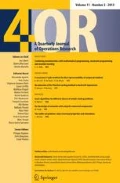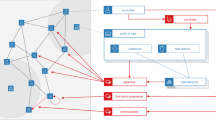Abstract
Motivated by applications in retail, online advertising, and cultural markets, this paper studies the problem of finding an optimal assortment and positioning of products subject to a capacity constraint in a setting where consumers preferences can be modeled as a discrete choice under a multinomial logit model that captures the intrinsic product appeal, position biases, and social influence. For the static problem, we prove that the optimal assortment and positioning can be found in polynomial time. This is despite the fact that adding a product to the assortment may increase the probability of selecting the no-choice option, a phenomenon not observed in almost all models studied in the literature. We then consider the dynamics of such a market, where consumers are influenced by the aggregate past purchases. In this dynamic setting, we provide a small example to show that the natural and often used policy known as popularity ranking, that ranks products in decreasing order of the number of purchases, can reduce the expected profit as times goes by. We then prove that a greedy policy that applies the static optimal assortment and positioning at each period, always benefits from the popularity signal and outperforms any policy where consumers cannot observe the number of past purchases (in expectation).
Similar content being viewed by others
Notes
Profit-ordered assortment are sometimes referred as revenue-ordered assortments.
Parameter d, which is the social signal, only appears as an argument of the social influence function, which is an arbitrary positive and non-decreasing function. Hence, all results hold for any social signal that is a positive and non-decreasing function of the number of purchases.
References
Abeliuk A, Berbeglia G, Cebrian M, Van Hentenryck P (2015) The benefits of social influence in optimized cultural markets. PloS One 10(4):e0121934. doi:10.1371/journal.pone.0121934
Berbeglia G, Joret G (2015) Assortment optimisation under a general discrete choice model: a tight analysis of revenue ordered assortments. Available at SSRN 2620165
Block HD, Marschak J (1960) Random orderings and stochastic theories of responses. Contrib probab Stat 2:97–132
Bront JJM, Méndez-Díaz I, Vulcano G (2009) A column generation algorithm for choice-based network revenue management. Oper Res 57(3):769–784
Buscher G, Cutrell E, Morris MR (2009) What do you see when you’re surfing?: using eye tracking to predict salient regions of web pages. In: Proceedings of the SIGCHI conference on human factors in computing systems, pp 21–30. ACM
Craswell N, Zoeter O, Taylor M, Ramsey B (2008) An experimental comparison of click position-bias models. In: Proceedings of the 2008 international conference on web search and data mining, pp 87–94. ACM
Daly Andrew, Zachary Stanley (1978) Improved multiple choice models. Determ Travel Choice 335:357
Davis J, Gallego G, Topaloglu H (2013) Assortment planning under the multinomial logit model with totally unimodular constraint structures. Technical report, Department of IEOR, Columbia University
Davis JM, Gallego G, Topaloglu H (2014) Assortment optimization under variants of the nested logit model. Oper Res 62(2):250–273
Dreze Xavier, Hoch Stephen J, Purk Mary E (1995) Shelf management and space elasticity. J Retail 70(4):301–326
Engstrom P, Forsell E (2014) Demand effects of consumers’ stated and revealed preferences. Available at SSRN 2253859
Gallego G, Iyengar G, Phillips R, Dubey A (2004) Managing flexible products on a network. Technical report, Columbia University, New York
Hardy GH, Littlewood JE, Polya G (1952) Inequalities. Cambridge University Press, Cambridge
Hummel P, McAfee RP (2014) Position auctions with externalities. In: Tie-Yan Liu, Qi Qi, Yinyu Ye (eds) Web and Internet Economics: Proceeding of the 10th International Conference, WINE 2014, Beijing, China, 14–17 December 2014
Joachims T, Granka L, Pan B, Hembrooke H, Gay G (2005) Accurately interpreting clickthrough data as implicit feedback. In: Proceedings of the 28th annual international ACM SIGIR conference on research and development in information retrieval, pp 154–161. ACM
Kempe D, Mahdian M (2008) A cascade model for externalities in sponsored search. In: Papadimitriou, Christos, Zhang, Shuzhong (eds) Internet and Network Economics. Proceedings of the 4th International Workshop, WINE 2008, Shanghai, China, 17–20 December 2008
Krumme C, Cebrian M, Pickard G, Pentland S (2012) Quantifying social influence in an online cultural market. PloS One 7(5):e33785. doi:10.1371/journal.pone.0033785
L’Ecuyer P, Maillé P, Stier-Moses N, Tuffin B (2015) Revenue-maximizing rankings for online platforms with quality-sensitive consumers. Technical Report: Les Cahiers du Gerad, G-2015-73. University of Montreal, Montreal, Canada
Lerman K, Hogg T (2014) Leveraging position bias to improve peer recommendation. PloS One 9(6):06
Liu Q, van Ryzin G (2008) On the choice-based linear programming model for network revenue management. Manuf Serv Oper Manag 10(2):288–310
Duncan Luce R (1965) Individual choice behavior. Wiley, New York
Maillé Patrick, Markakis Evangelos, Naldi Maurizio, Stamoulis George D, Tuffin Bruno (2012) Sponsored search auctions: an overview of research with emphasis on game theoretic aspects. Electron Commer Res 12(3):265–300
Rusmevichientong P, Shen Z-JM, Shmoys DB (2010a) Dynamic assortment optimization with a multinomial logit choice model and capacity constraint. Oper Res 58(6):1666–1680
Rusmevichientong P, Shmoys D, Topaloglu H (2010b) Assortment optimization with mixtures of logits. Technical report, School of IEOR, Cornell University
Salganik Matthew J, Dodds Peter Sheridan, Watts Duncan J (2006) Experimental study of inequality and unpredictability in an artificial cultural market. Science 311(5762):854–856
Talluri Kalyan, Van Ryzin Garrett (2004) Revenue management under a general discrete choice model of consumer behavior. Manag Sci 50(1):15–33
Tucker Catherine, Zhang Juanjuan (2011) How does popularity information affect choices? A field experiment. Manag Sci 57(5):828–842
Williams HCWL (1977) On the formation of travel demand models and economic evaluation measures of user benefit Environ Plan 9(3):285–344
Acknowledgments
We thank the reviewers for their constructive remarks and suggestions. NICTA is funded by the Australian Government through the Department of Communications and the Australian Research Council through the ICT Centre of Excellence Program.
Author information
Authors and Affiliations
Corresponding author
Rights and permissions
About this article
Cite this article
Abeliuk, A., Berbeglia, G., Cebrian, M. et al. Assortment optimization under a multinomial logit model with position bias and social influence. 4OR-Q J Oper Res 14, 57–75 (2016). https://doi.org/10.1007/s10288-015-0302-y
Received:
Revised:
Published:
Issue Date:
DOI: https://doi.org/10.1007/s10288-015-0302-y




